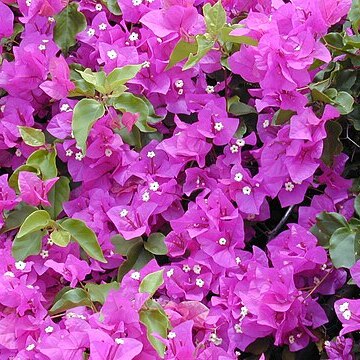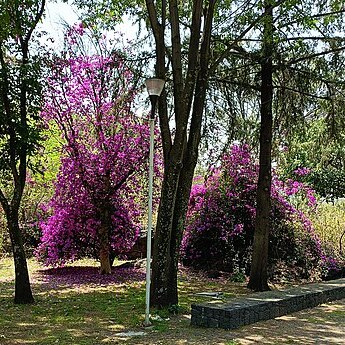Coarse climbers to 25 m, with supra-axillary spines (abortive inflorescences), more or less puberulous. Leaves (sub)opposite, ovate to elliptic-oblong. Inflorescences supra-axillary above a bud, the peduncle bearing a single apical triad of flowers (sometimes a second one lower), or the triads in dichasia 1—2(-3) times branched, each triad consisting of 3 subsessile, cordate, persistent, coloured bracts each with a single adnate pedicel. Perianth tubular, limb 5(-4)-lobed; tube with 5(-4) ribs, after anthesis its top twisted, its base persistent. Stamens (4-)5-8(-10), unequal, not exserted. Gynaecium shorter than the tube; stigma fimbriate. Anthocarp spindle-shaped, coriaceous, 5-ribbed, not viscid; embryo longitudinally convolute.
Shrubs or small trees, sometimes climbing. Branches spiny. Leaves alternate, petiolate, leaf blade ovate or elliptic-lanceolate. Inflorescences axillary, pedunculate, 3-flowered cymes, each flower subtended by a persistent, often brightly colored, ovate bract adnate to the pedicel, often grouped into terminal panicles. Flowers bisexual; pedicel adnate to the midvein or the bract. Perianth connate, limb rose or yellow, funnelform, 5-6-lobed, lobes short. Stamens 5-10, included; filaments shortly united at base. Ovary fusiform, stipitate. Style lateral, short linear; stigma fimbriate. Fruit cylindric or clavate, 5-ribbed, without sticky glands. Seed: testa thin; embryo curved, cotyledons convolute, enclosing the endosperm.
Climbing or scrambling shrubs, sometimes with axillary stem spines, less commonly arborescent; stems not swollen at nodes. Lvs alternate, petiolate. Fls ☿, rather small, usually in clusters of 3, each subtended by a large variously coloured bract. Pedicels adnate to midrib of bract. Perianth tubular, constricted at c. middle of tube, widened below, 5-ridged; limb short, usually 5-lobed with ridges of tube terminating at the apex of the lobes, cream, yellow or pink, persistent. Stamens (4)-8-(10), unequal, free, or connate at base, not filiform, included. Ovary stipitate; style short; stigma often irregularly lobed. Anthocarp 5-ribbed, not viscid, falling with the attached bract and not invested by it.
Pending. See Spencer (1997).


